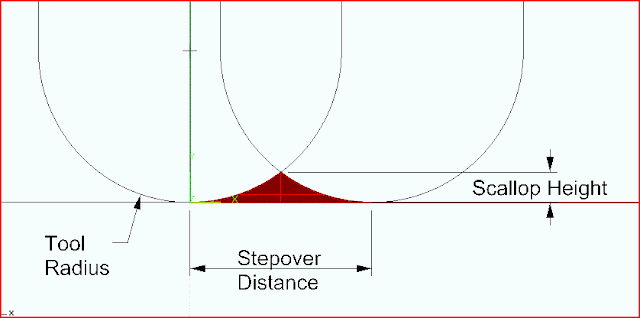What is stepover?
Stepover is the distance from the tool center between two passes. Increasing the stepover will result in shorter machining time, but also a rougher surface finish.
When milling with a flat end mill, or a facemill, the main parameters you can controll is machinetime and chipload, as the surface produced will be flat anyway. However, with a ballnose bit, it`s a different story. As the milling bit has a radius at it's end, It will leave a raised bit of material in between the passes.
This leftover material is called scallop.
The scallop heigth and width increases when stepover is increased, and decreased when the stepover is reduced. The scallop is marked in red in the following picture:
Using a previously generated toolpath, we can further investigate the stepover, and the effect it impacts on the surface.
Shown below, is three identical shapes, where the toolpaths generated has different stepovers, ranging from 0,5mm from left, to 2,5mm in the middle, and 5mm stepover to the rigth
The choosen tool in this case where a 10mm ballnose, and the machining times where as following:
0:09:17
0:02:09
0:01:16
When you have simulated a toolpath in Fusion 360, you can download the resulting geometry as an STL file.
I downloaded all the resulting files, then rendered them lined up, to display the resulting surfaces.
The results appears to conjoin with the theory, a finer stepover results in a finer surface quality, at the expence of machining time.
The stepover parameter can be reached by selecting the 'passes' tab when producing 3D toolpaths.




Thanks a lot sir for the knowledge.
SvarSlett